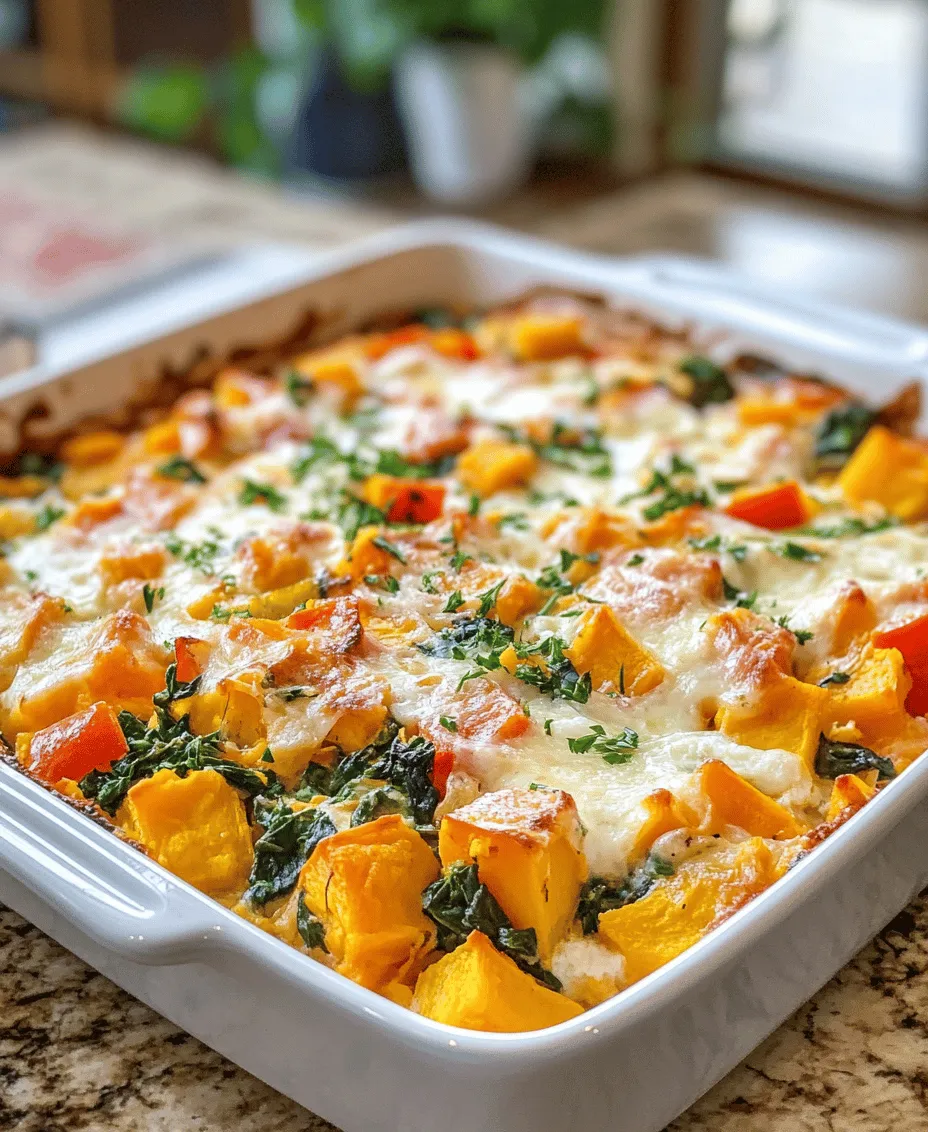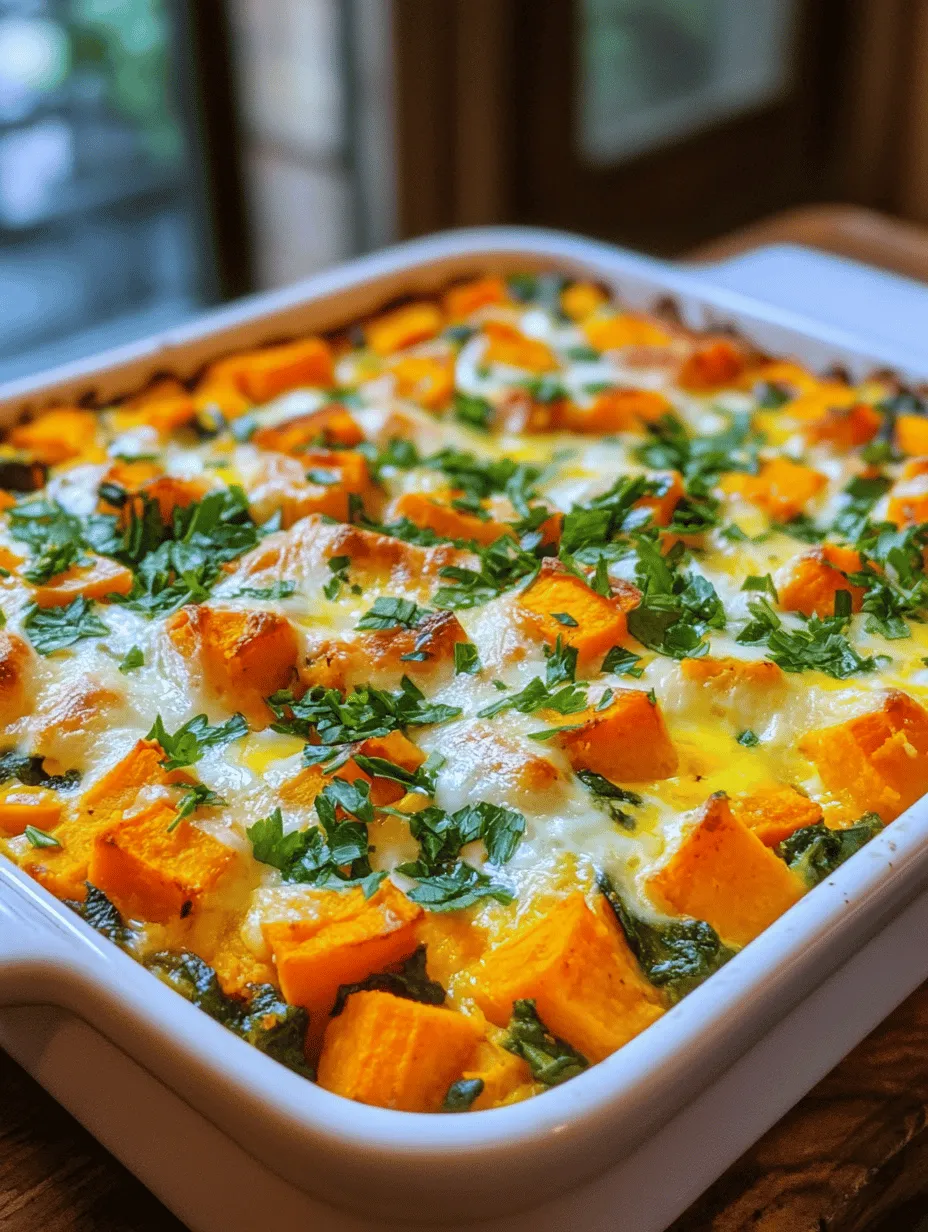Introduction
In the realm of breakfast options, nothing quite matches the satisfaction of a nourishing and hearty meal that sets a positive tone for the day ahead. The Sweet Potato & Egg Breakfast Casserole emerges as a shining star in this category, blending wholesome ingredients into a deliciously filling dish. This casserole captures the natural sweetness of sweet potatoes, while also providing a robust source of protein from eggs and a medley of colorful vegetables.
Whether you’re rushing out the door on a busy weekday or leisurely enjoying a weekend brunch, this casserole is designed to meet the needs of any breakfast lover. Not only is it easy to prepare, but it also allows for flexibility in ingredients, making it an ideal choice for families and gatherings alike. In this article, we will delve into the intricacies of this recipe, exploring its health benefits, ingredient breakdown, and a detailed step-by-step guide to crafting this delightful casserole at home.
Understanding Sweet Potatoes: A Nutritional Powerhouse
Sweet potatoes are not just a tasty addition to your breakfast; they are also a nutritional powerhouse. Packed with vitamins and minerals, these vibrant tubers offer numerous health benefits that contribute to a balanced diet.
Health Benefits of Sweet Potatoes
– Rich in Vitamins and Minerals: Sweet potatoes are an excellent source of vitamin A, thanks to their high beta-carotene content. They also provide significant amounts of vitamin C, potassium, and manganese, all of which play vital roles in maintaining overall health.
– High in Fiber and Antioxidants: The fiber in sweet potatoes aids digestion and helps maintain a healthy gut, while antioxidants combat oxidative stress in the body. This combination can support heart health and reduce the risk of chronic diseases.
– Low Glycemic Index for Sustained Energy: Unlike regular potatoes, sweet potatoes have a lower glycemic index, which means they release energy slowly into the bloodstream. This characteristic helps to keep you feeling full longer and provides sustained energy throughout the morning.
Incorporating Sweet Potatoes into Your Diet
Sweet potatoes are incredibly versatile and can be incorporated into a wide range of dishes beyond breakfast. From soups and stews to salads and casseroles, they can enhance the flavor and nutritional profile of any meal. Choosing sweet potatoes over regular potatoes can also provide additional health benefits due to their fiber content and antioxidant properties.
Ingredient Breakdown for Sweet Potato & Egg Breakfast Casserole
To create a delicious Sweet Potato & Egg Breakfast Casserole, it’s essential to understand the key ingredients that contribute to its flavor and nutritional value.
Overview of the Main Ingredients
– Sweet Potatoes: These serve as the base for our casserole, providing a naturally sweet flavor and a creamy texture when baked. Their nutritional benefits, including high levels of beta-carotene and fiber, make them an ideal choice for a wholesome breakfast.
– Spinach: The addition of spinach not only boosts the nutritional content of the casserole but also adds a pop of vibrant green color. Leafy greens like spinach are rich in vitamins A, C, and K, as well as iron and calcium, making them an essential part of a balanced breakfast.
– Eggs: Eggs are a cornerstone of this dish, offering high-quality protein that helps keep you full and satisfied. They also contribute a rich flavor and creamy texture to the casserole, making them an indispensable ingredient.
– Cheese: While cheese is optional, it enhances the overall flavor and creaminess of the dish. You can choose from a variety of cheeses, such as cheddar, feta, or even dairy-free alternatives, depending on your dietary preferences.
Detailed Look at Seasonings and Oils
The right seasonings and oils can elevate the flavor profile of your Sweet Potato & Egg Breakfast Casserole.
– Enhancing Flavor with Garlic, Onion, and Bell Peppers: Aromatics like garlic and onion add depth to the dish, while bell peppers contribute sweetness and a slight crunch. These ingredients work together to create a savory base that complements the sweetness of the sweet potatoes.
– The Significance of Olive Oil in Cooking: Using olive oil not only helps to sauté the vegetables but also adds healthy fats that can enhance the absorption of fat-soluble vitamins found in sweet potatoes and spinach. Additionally, olive oil provides a rich flavor that ties the entire dish together.
Step-by-Step Instructions for Preparation
Now that we’ve explored the ingredients and their benefits, it’s time to dive into the preparation of the Sweet Potato & Egg Breakfast Casserole. Following these steps will ensure that your casserole is perfectly cooked and bursting with flavor.
Preheating the Oven: Why the Right Temperature Matters
Before you begin preparing the ingredients, it’s crucial to preheat your oven to the ideal temperature. Generally, 375°F (190°C) is perfect for casseroles, allowing for even cooking and a beautifully golden top. Preheating ensures that your casserole bakes uniformly, preventing any sogginess and helping to achieve that perfect texture.
Preparing the Sweet Potatoes: Techniques for Perfect Texture
To achieve the best results, the sweet potatoes should be prepared properly. Here’s how to do it:
1. Peel and Dice: Start by peeling the sweet potatoes with a vegetable peeler. Once peeled, dice them into uniform cubes (about 1-inch in size). This will ensure even cooking.
2. Boil or Roast: You have two options here:
– Boiling: Place the diced sweet potatoes in a pot of salted water and bring to a boil. Cook for about 5-7 minutes, or until just tender. Drain and set aside.
– Roasting: Alternatively, you can roast the sweet potatoes for added flavor. Toss the diced sweet potatoes in olive oil, salt, and pepper, then spread them on a baking sheet. Roast in the preheated oven for about 20 minutes, or until tender and lightly caramelized.
3. Sautéing the Vegetables: While the sweet potatoes are cooking, heat a tablespoon of olive oil in a skillet over medium heat. Add chopped onions, bell peppers, and minced garlic, sautéing until softened and fragrant. This step is crucial for developing the base flavors of your casserole.
Once the sweet potatoes are prepared and the vegetables are sautéed, you’ll be ready to combine all the ingredients and bake your casserole to perfection. Stay tuned for the next part, where we’ll complete the assembly and baking process, ensuring that your Sweet Potato & Egg Breakfast Casserole is a delicious success.

Tips for Dicing and Cooking Sweet Potatoes Evenly
When preparing sweet potatoes for your breakfast casserole, achieving even cooking is essential to ensure that every bite is tender and flavorful. Here are some tips for dicing and cooking sweet potatoes evenly:
1. Choose Uniform Sizes: Start by selecting sweet potatoes of similar sizes to ensure even cooking. When dicing, aim for ½-inch cubes. This size promotes uniform cooking and allows the sweet potatoes to caramelize nicely.
2. Peel and Wash: Before dicing, wash the sweet potatoes thoroughly to remove any dirt. Peeling is optional; if you prefer the added nutrients and texture, you can leave the skin on.
3. Use a Sharp Knife: A sharp knife makes all the difference in achieving clean cuts. Dull knives can lead to uneven pieces and increase the risk of injury.
4. Cook in Batches: If you have a large amount of sweet potatoes to cook, consider working in batches. This method prevents overcrowding in the pan, allowing for better caramelization and texture.
5. Parboil for Even Cooking: An optional step is to parboil the diced sweet potatoes for 5-7 minutes before sautéing or baking. This technique partially cooks the potatoes, ensuring they finish cooking at the same time as the eggs in the casserole.
Sautéing Vegetables: Ensuring Optimal Flavor and Nutrition
Sautéing the vegetables before adding them to the casserole enhances flavor and maintains their nutritional content. Here’s how to get the most out of your sautéed vegetables:
1. Heat the Pan: Use a non-stick skillet or a well-seasoned cast-iron skillet. Preheat the pan over medium heat and add a drizzle of olive oil or a knob of butter for flavor.
2. Add Aromatics First: Start with onions and garlic, as they take longer to cook compared to other vegetables. Sauté them until they are fragrant and translucent, about 3-4 minutes.
3. Layering Vegetables: Add the dicing sweet potatoes next, followed by any other vegetables you may be using (such as bell peppers or spinach). Stir occasionally to ensure even cooking and prevent sticking.
4. Seasoning: Season the vegetables with salt, pepper, and any herbs or spices you prefer. This step is crucial for infusing flavors into the vegetables before they are baked in the casserole.
Importance of Cooking Order and Timing
The order in which you cook your ingredients can significantly impact the final flavor and texture of your breakfast casserole. Here are some guidelines to follow:
1. Cook Harder Vegetables First: Start with sweet potatoes and any other dense vegetables, as they require more time to become tender.
2. Add Softer Vegetables Later: Vegetables like spinach or zucchini should be added toward the end of the sautéing process, as they cook quickly and should retain some texture in the casserole.
3. Timing: Aim for about 8-10 minutes of sautéing for the sweet potatoes until they are just tender but not fully cooked. They will finish baking in the casserole.
Creating the Egg Mixture: Achieving the Perfect Consistency
The egg mixture is the heart of your breakfast casserole. To achieve the perfect consistency, follow these steps:
1. Whisking Eggs: Crack the eggs into a mixing bowl. For a fluffy texture, use a whisk or an electric mixer to beat the eggs vigorously. Incorporate air into the mixture for a lighter texture.
2. Incorporate Dairy: Depending on your preference, add milk, cream, or a dairy substitute to the eggs. This addition not only enhances creaminess but also contributes to a richer flavor.
3. Seasoning: Don’t forget to season your egg mixture with salt, pepper, and any other spices that complement your casserole. A touch of nutmeg can add warmth and depth.
4. Cheese Addition: If you’re adding cheese, mix it into the egg mixture before combining with the other ingredients. This ensures even distribution throughout the casserole.
Combining Ingredients: Layering for Even Cooking
Layering is crucial for ensuring that all flavors meld together and that each ingredient cooks evenly. Here’s how to do it:
1. Start with Sweet Potatoes: In a greased baking dish, spread the sautéed sweet potatoes and vegetables out evenly as the bottom layer.
2. Pour Egg Mixture: Gently pour the prepared egg mixture over the sweet potatoes. Use a spatula to stir slightly, ensuring that the egg mixture coats all the vegetables.
3. Top with Cheese: If you’re using cheese, sprinkle it on top of the casserole right before baking. This will create a delicious, golden crust as it bakes.
Baking the Casserole: Knowing When It’s Done
Baking your breakfast casserole to perfection is the final step. Here’s how to recognize when it’s done:
1. Baking Time: Bake the casserole in a preheated oven at 350°F (175°C) for about 30-35 minutes.
2. Signs of Doneness: Look for the edges to be set and the center to be slightly jiggly—this indicates that the casserole is perfectly cooked. It will continue to firm up as it cools.
3. Toothpick Test: Insert a toothpick into the center of the casserole. If it comes out clean or with minimal egg residue, your casserole is done.
Serving Suggestions and Pairings
This Sweet Potato & Egg Breakfast Casserole is versatile and can be served in a variety of ways. Here are some suggestions to enhance your meal:
Best Accompaniments for the Casserole
– Fresh Fruit: Serve the casserole alongside sliced avocados, berries, or orange segments to add brightness and freshness.
– Green Salad: A light green salad with a citrus vinaigrette complements the richness of the casserole.
Suggested Side Dishes to Enhance the Meal
– Whole Grain Toast: Pair with toasted whole grain bread or a hearty bagel to add crunch and texture.
– Yogurt Parfait: A yogurt parfait with granola and fresh fruit can provide a refreshing contrast to the warm casserole.
Beverage Pairings for Breakfast or Brunch
– Coffee or Tea: A warm cup of coffee or herbal tea makes a comforting drink to enjoy alongside your breakfast.
– Fresh Juice: Freshly squeezed orange juice or a green smoothie can add a healthy touch.
Creative Serving Ideas
– Presentation: For special occasions, consider serving the casserole in individual ramekins or cast-iron skillets for an appealing presentation.
– Garnishes: Top with fresh herbs like parsley or chives for a pop of color and added flavor right before serving.
Exploring Variations and Customizations
One of the best aspects of the Sweet Potato & Egg Breakfast Casserole is its adaptability. Here are some ideas for variations and customizations:
Adapting the Recipe for Dietary Preferences
– Vegetarian and Vegan Alternatives: To make this dish vegetarian, you can add extra vegetables like mushrooms, zucchini, or kale. For a vegan version, substitute eggs with a mixture of silken tofu blended with nutritional yeast and turmeric for color.
– Gluten-Free Options and Ingredient Swaps: If you need a gluten-free option, ensure all ingredients (like the cheese) are gluten-free. You can also use chickpea flour to create a custard-like egg substitute.
Incorporating Seasonal Vegetables
– Seasonal Adjustments: Use seasonal vegetables depending on what’s fresh in your area. Spring can bring in asparagus or peas, while autumn can feature butternut squash or brussels sprouts.
Conclusion
In conclusion, the Sweet Potato & Egg Breakfast Casserole is a versatile, nutritious, and delicious option for anyone looking to elevate their breakfast game. With its delightful combination of flavors and textures, this casserole is not only easy to prepare but also provides a hearty meal that can be enjoyed any time of day. By understanding the ingredients, preparation methods, and variations, readers can confidently create their own version of this delightful dish, ensuring a satisfying and wholesome start to their day.
This recipe is perfect for busy mornings or leisurely brunches with family and friends. Whether you stick with the classic version or explore creative customizations, it promises to be a hit at the breakfast table. Don’t hesitate to experiment and make it your own!



